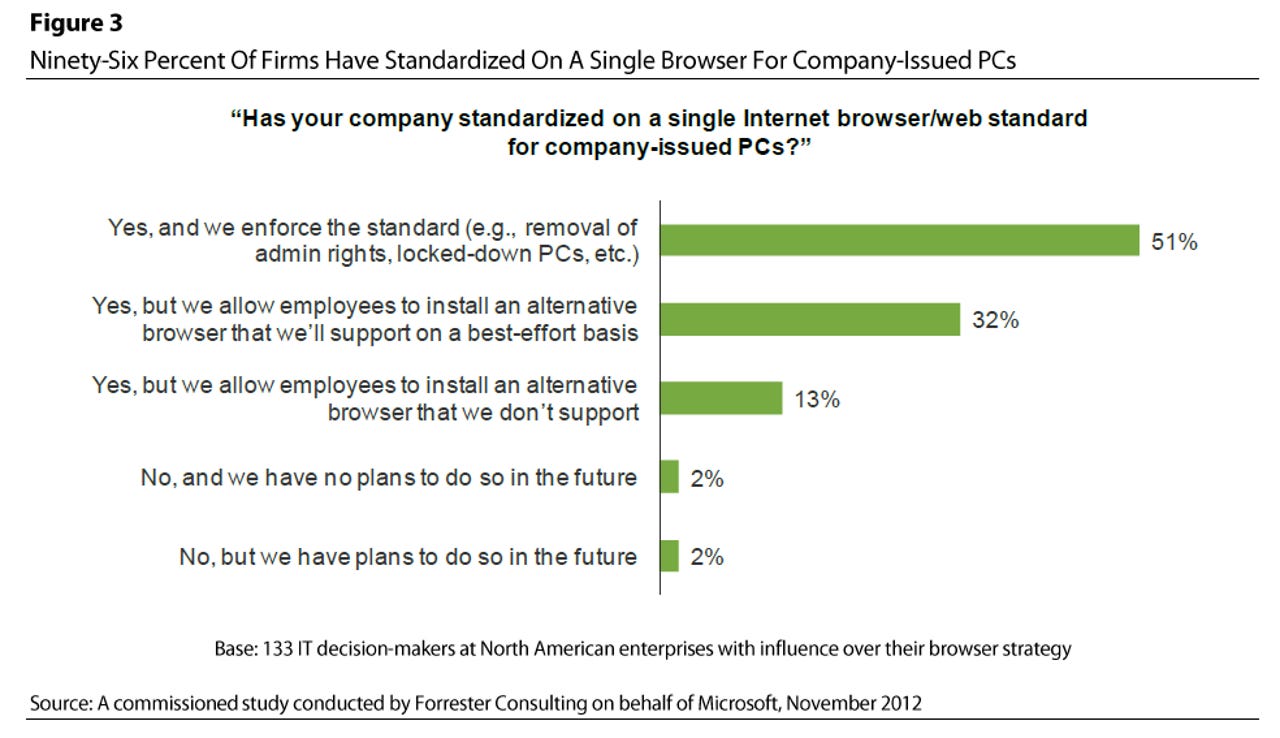Will standardizing on a single browser today help keep IT costs at bay?

I don't often cover Microsoft-commissioned studies because of the seeming increased potential for biased results. But I'm bending my rules with a new study by Forrester Research commissioned by Microsoft about standardizing on a single browser in the enterprise.
Microsoft highlighted the study and provided a free download link for it via its "Exploring IE" blog this week. The reason I decided to take a look was my interest in how Microsoft is campaigning to get business users to standardize on Internet Explorer (IE) -- and hopefully not the older, not-so-standards-compliant versions of it.
Forrester's report, "The Business Case for Standardizing on a Single Modern Browser in the Enterprise," highlights answers from 133 North American IT pros and business-decision makers surveyed. Ninety-six percent of those surveyed said their firms encouraged standardization on a single browser for company-issued PCs. (So bring-your-own devices are excluded here.) But only 51 percent of those surveyed said single-browser use was enforced by lockdowns at their companies.

From the summary on the Exploring Microsoft blog post (which doesn't mention, by the way, that Microsoft commissioned this study -- but which Forrester does make quite clear at the top of its downloadable report):
"Forrester found that firms spend an extra $4,200 per web app annually to support multiple browsers. For a large corporation, that translates to almost $400,000 per year just for web apps. Any potential benefits were clearly outweighed by support, maintenance, and other costs - as most firms with multiple browsers experienced cost increases in excess of 20% overall. This is in line with conventional wisdom, which says to pick one browser but develop sites to common web standards."
Forrester found security and patch management, testing, and training (and to a lesser extent app-development costs) increased when businesses allowed deployment of more than one company-sanctioned browser.
Forrester analysts didn't tell those surveyed who commissioned this study (according to a note in the results). Nor did Forrester's report make any recommendations about on which single browser enterprises should standardize.
But Microsoft's blog write-up plays up the fact that IE10 is integrated with Windows 8 -- just as IE9 was with Windows 7. So if an enterprise has Windows, the implication is IE is the single browser you already have by default and the one that is the obvious choice for those looking to standardize on a single browser.
Even though IE's share is holding roughly constant at just over 50 percent of the market at this point, not every enterprise user and admin likely agrees that standardizing on one browser is a no brainer. Browsium, for example, is taking a different tack and is focused on giving IT browser-management tools via its Catalyst product (now in beta) for multi-browser shops.
"It’s not about only using one browser. It’s about giving IT the browser management tools they need to retain control, because the multi-browser enterprise is here to stay," said Gary Schare, Browsium President and Chief Operating Officer.